ICSAVE: Saving Lives, One School at a Time

To read the original published version of this article, see page 46 of Dillon Precision’s July 2024 eBluePress. This version has photos that were not in the original.
*****
January 8, 2011
To say the medics and the cops were frustrated would be a massive understatement. On-duty EMS STILL had not been cleared to approach the La Toscana Village shopping center where 19 people had been shot.
The Safeway parking lot was already crawling with Pima County deputies, and officers from other local agencies. More tires were screeching in every minute. One deputy’s cruiser was actually captured by a speed camera with all four wheels in the air. The murderer had been stopped, but now the officers sought any additional bad guys. Unable to wait for the medics, the cops started treating victims with their own IFAKs.
The EMS responders were initially held back by policies adopted throughout the nation to keep them safe. The vast majority of fire fighters were neither trained nor equipped to operate in kinetic environments. They had SCBA for smoke. They had bunker gear to protect them from broken glass. They would not hesitate to run into burning buildings that were about to collapse, if lives could be saved. Many fire departments even had specialists trained to deal with radioactive HazMat. But one bozo with a pistol, who’d already been twisted up like a pretzel, disarmed, and handcuffed, was considered “too dangerous,” until it was absolutely certain that he had no friends within half a mile.
The police had NOT stopped the killer on January 8, 2011. His death spree had been going along alright, with the element of surprise in his favor, until he shot the wrong guy: retired Army Colonel Bill Badger. 74-year-old Badger grabbed him by the arm and hit him as Roger Salzgeber nailed him a chair.

They all went to the ground. Armed citizen Joseph Zamudio rushed to the sounds of the commotion, but seeing the wrestling match in progress, realized that his pistol was no longer the tool of choice to solve the problem. He jumped on the pile. Patricia Maisch focused on controlling the perpetrator’s weapon.
Later the killer, elated about murdering a nine-year-old-girl and five others, and that he was still alive to brag about it, babbled incessantly. One of the deputies assigned to watch him said “What happened to your face? Did that old man beat you up?” That shut his cake hole.
When some of those who had responded on January 8 later spoke with Ron Barber, the second person shot that day, he told them that first responders had saved a lot of lives, but the reason they were having that conversation was because of a bystander named Anna Ballis. Ron had been shot in the cheek; that wound was gruesome, but it had missed his carotid. He was bleeding to death, instead, from his femoral vein. Ballis applied direct pressure to his hip for 30 minutes, saving Barber’s life.

A severe bleed can kill you in minutes. You don’t have time to wait till the police have cleared the entire area. That lesson had been learned at Columbine in 1999.
High capacity 9mms like the Browning Hi-power had been around since the 1930s.

The US government unloaded thousands of surplus M-1 carbines, short, semi-automatic, magazine fed rifles chambered in an intermediate cartridge (essentially “assault rifles”—they even had bayonet lugs) on the civilian market after WWII.

But there was no blood bath then. The mass execution of strangers was frowned upon in those days.
Now, too many idiots think it’s cool to murder piles of people they don’t even know, with guns, cars, bombs, knives, airliners . . .
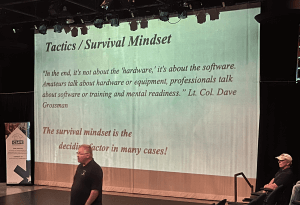
Dr. David Grossman points to cogent data correlating the rise of active violence with the availability of gory video games, DVDs, and streaming that expose young developing minds to graphic, repetitive murder. “Revenge thrillers” are a movie genre. Shortened or non-existent treatment of mental patients clearly plays a part. No doubt many who perpetrate these heinous crimes are craving the instant fame provided by the news media.
But whatever the complex causes, it isn’t going away.
In 2007, having experienced the scourge of active violence through the lenses of their respective professions, several like-minded fire, EMS, law enforcement and military friends founded ICSAVE, Integrated Community Solutions to Active Violence Events. They had come to two inescapable conclusions:
- The knights might or might not slay the dragon, but it’s always too late for the damsel. If she doesn’t want to be barbecued, the princess needs to fend for herself, at least until the knights get there. Mass murderers are typically untrained InCel losers, not Navy SEALs. The public needs to know those clowns can be defeated, and how.
- We have to get medically trained responders to the victims before they bleed out.
ICSAVE’s first classes were on how police, EMS, and fire departments could work together to save lives during active violence.

But while the students at the operating level were eager to cooperate, their respective administrations were slow to change.
*****
Bill and Ted’s Bloody Adventure
Fast forward to 2019. 15-year-old “Ted” heard his father “Bill” (not their real names) calling from the shop. Dad had accidentally severed his brachial artery with a power tool.
Their house was outside of Sierra Vista, Arizona, over an hour and a half from the nearest Level 1 trauma center.
Fortunately, Ted had recently attended a two-hour ICSAVE Bleeding Control class. Among other things, ICSAVE (pronounced “icy save,” like a successful rescue from Arctic waters) had taught Ted how and when to apply a tourniquet.

Ted had returned from “B-Con” stoked. He and his father loved to hike and camp. They decided to invest in some medical gear. When his dad was bleeding out in the shop, Ted dug out the tourniquet.
When the ambulance finally got there, they found Bill sitting calmly, with a properly placed tourniquet that had stopped the bleeding completely. “Did you put that on?” they asked.
“No,” Bill said, grimacing a bit through the pain but beaming with pride. “My son did.”
An hour and a half later, when they got him to the ER, the trauma docs complimented the way the tourniquet had been applied. They rolled Bill into a surgical suite and repaired the lacerated vessels with Ted’s tourniquet still in place. Now, Bill has full use of both arms. Most importantly, he didn’t bleed to death on the floor of his shop.
Theirs is only one of many examples of trained citizens saving lives.
ICSAVE teaches over 42 different lifesaving courses to educators, workers, parishioners, non-profits–anyone who is willing to learn, and willing to step up when things go wrong.
ICSAVE’s volunteers are just that. There are no paid employees, although we’ve never been known to turn down a free lunch.
*****
Courses for Immediate Responders
“First” responders should be appreciated for what they do. Just don’t think they’re first. The first people on the scene are the ones who are there when it goes down. We call them “immediate” responders.
ICSAVE and the Arizona Church Security Network (AZCSN, which serves all houses of worship, including synagogues, mosques, and temples, as well as churches) developed their own Active Violence response model, called I-LIVED, for immediate responders. I-LIVED training takes about six hours.

The main difference between I-LIVED and other Active Violence courses is that ICSAVE’s program always has been, and remains, entirely free to the students. We’re not opposed to capitalism—most of us have spent our lives defending it—we just don’t want anyone to ever die because an administrator couldn’t figure out how to work training into the budget.
I-LIVED is hands-on, interactive training. Most Active Violence education is computer-based or lecture-only, largely due to liability concerns. But when it really goes down, your kids’ teacher will be far more likely to respond effectively having already heard the sounds of gunfire, having built effective barricades, having actually thrown objects (we use soft plastic balls) at someone, perhaps even having practiced off lines and disarms. ICSAVE instructors shoot at them with Nerf rifles.
One of ICSAVE’s most empowering demonstrations is called “Riding and Killing the Dragon.” A student with a glove, eye and ear protection gets inside the minimum effective range of an AR-15, between the shooter and the muzzle, holding onto the magazine to stay inside.
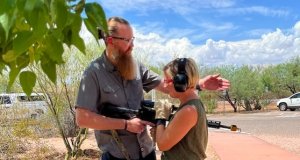
As the “bad guy” role player fires blanks, the student induces a stove-pipe stoppage by blocking the ejection port with their gloved hand (it can be done bare handed; the glove prevents blisters in training). People who try it have a little trepidation at first, but then are surprised by how ridiculously easy it is to put an active killer’s AR out of commission, at least long enough to take his secondary weapon(s) or to subdue the assailant.
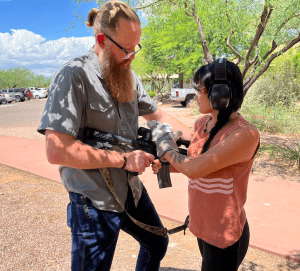
THIS DRILL IS DANGEROUS IF NOT PERFORMED UNDER TRAINED SUPERVISION. FLAME EJECTING FROM GAS PORTS OF PISTON DRIVEN RIFLES CAN MAIM. ICSAVE uses a DGI AR with a long handguard to prevent injury. We have a two-factor authentication process to ensure that only blank ammunition gets into blank guns.
*****
Courses for First Responders and Military
Another priority focus of ICSAVE’s strategy is to get EMS responders into the “warm zone” while the victims in it are still at body temperature. The answer? Rescue Task Forces (RTFs): teams of paramedics and EMTs escorted by police officers, going into areas previously attacked by the killers, while different police contact teams hunt down the suspects. ICSAVE didn’t invent the RTF concept, but was one of the first and most tenacious organizations promoting the idea.
RTFs have needed proponents. The RTF strategy got a lot of pushback, especially from old school chiefs who thought they were “protecting” their firefighters from unnecessary risk. Orlando firefighters got close, but were unable to convince their chain of command to sign off on establishing RTFs before the 2016 Pulse Nightclub tragedy.

Now RTFs (they go by different names in different places) are the nation-wide standard. More and more departments are establishing inter-agency cooperation agreements, training together with LE.
It’s working. Death rates are going down, even as assault rates continue to rise, largely because of faster police and EMS response. Uvalde and Parkland were glaring exceptions, not the rule. When the body count isn’t high, you don’t hear about it.
ICSAVE teaches a Tactical Emergency Casualty Care (TECC) course called Public Safety Integration (PSI). Police learn medical skills. Firefighters learn tactics. Both professions learn to work together responding to active violence scenarios.
Courses often include IED recognition, since improvised explosive devices are an emerging trend in active violence.

Local nursing or theatre students sometimes play the moulaged victims.
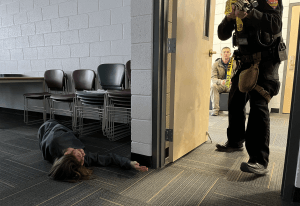
ICSAVE also teaches Tactical Combat Casualty Care to military deployers.
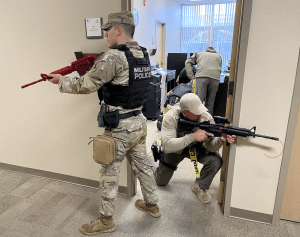
*****
The Immediate Responder Videos
During the pandemic, ICSAVE created free online certification programs. While they are no substitute for hands-on, interactive, scenario-driven, reality-based training, the videos are a good way to learn or to review concepts. You can find them on ICSAVE.org; go to Courses and click on Immediate Responder Campaign. If you want, you can even take a quiz afterward and print out a certificate for passing the online education.
ICSAVE’s Resources page also has a host of after-action reports and other sources of detailed, accurate information for those studying how to stop Active Violence or writing grants.
*****
Do You Hear the Call to Serve?
There is always more demand for ICSAVE’s free, credentialed training than there are days in the week, or volunteers to teach classes. ICSAVE’s talented unpaid cadre of active and retired public safety and military professionals do what they can, but they can’t be everywhere at once. We mostly teach in our home state of Arizona.
If you are (or were) a first responder, law enforcement officer, healthcare professional, military, or just have a desire to help, our communities can use your talents. ICSAVE would love to have you on our team. Email info@icsave.org to volunteer.
As of this writing [April 2025], ICSAVE’s professional, committed volunteers have trained over 276,845 people [the count was 215,122+ when this article was originally published by The Blue Press]. 16 lives have been saved–that we know of–by students using skills ICSAVE taught them. Our ultimate goal is to work ourselves out of a job.
